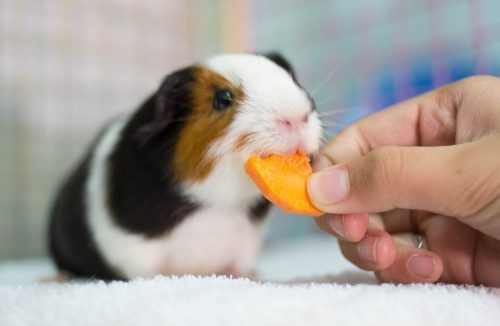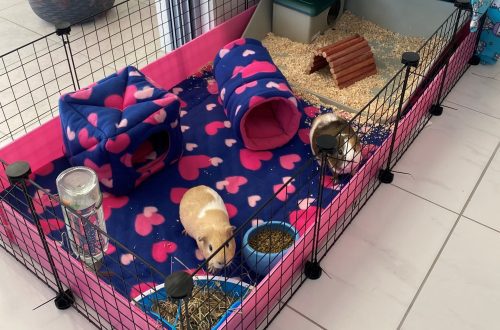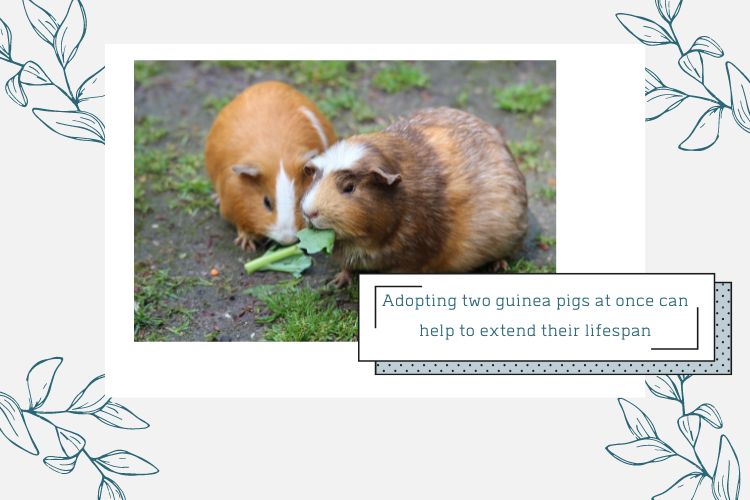
How many years do guinea pigs live at home: the average life expectancy of a rodent and its age by human standards
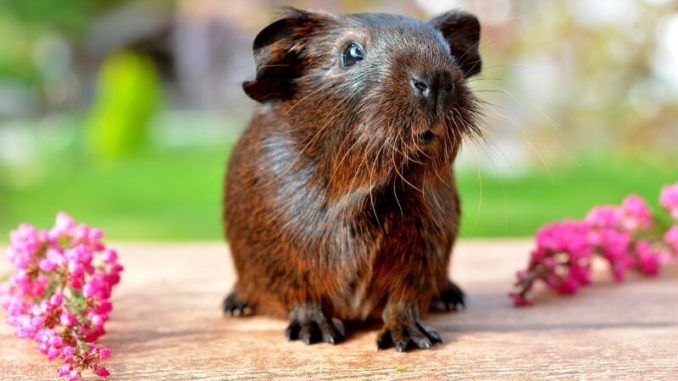
Parting with a pet is a difficult but irreversible moment, therefore, before acquiring an animal, it is important to understand how many years nature has given him, and how much can be added from above in the form of a bonus by independent efforts.
Our article will tell you how long guinea pigs live at home, what factors affect age indicators, and also explain how to extend the life of an animal and how to convert a rodent’s age into a human.
Contents
average life expectancy
Unlike other rodents that live 2-3 years, guinea pigs are considered long-lived, which bribes future owners.
Small animals that originated in the countries of South America gained popularity around the world after the visit of Europeans who transported them to other continents. Numerous selection works, which made it possible to develop new species, reduced the natural life span. A pig living in the wild can live up to 10 years. In this case, the duration entirely depends on the external environmental conditions (climate, predators), therefore, it can be 5 times lower.
At home, guinea pigs live from 5 to 7 years.
Lifespan depends on many factors, most of which are due to proper care.
IMPORTANT! The age record was set by an English rodent, slightly short of the mark of 15 years (it lacked 2 months).
Influence of interbreed differences
Among the factors affecting the life span of guinea pigs is the breed (although of all the reasons it plays the least role).
Existing varieties can be divided into 3 large groups.
Longhair
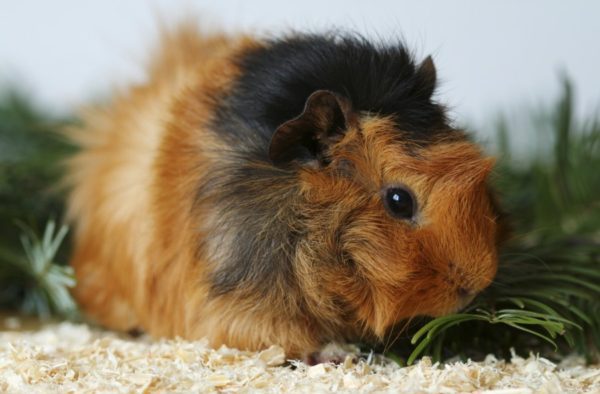
Such pets require careful grooming and average life is about 5-6 years… These include:
- Peruvian. It differs by the maximum length of the hairs and the obligatory bangs that cover the eyes.
- Rosette (Abyssinian). The bizarre growth of wool is characterized by a multidirectional arrangement, forming curls with clear boundaries (“rosettes”). For animals performing at exhibitions, the number of these curls is important (the owner of a smaller number loses).
- Sheltie. It is similar to the Peruvian, but has a kind of comb on the head (the fur is located in the opposite direction).
- Coronet. The long-haired result of crossing Sheltie and Crested, which stands out with a “crown” of wool.
Shorthair
Owners of short hair are distinguished by a wide color palette, do not require complex care and able to live up to 8 years… These include:
- Crested. Woolen white “rosette” on the head takes the form of a “crown”.
- American. One of the most popular types of animal with short hair. The classic version with a smooth, shiny coat that does not have “rosettes” or “crowns”.
- Texel. The hairs have a curly structure and are prone to frequent tangles, therefore, they require more thorough care than other representatives of this group.
- Himalayan. A rare breed with a unique color of the Siamese cat. Despite the lack of official recognition, the coloring gained popularity, which affected the final cost.
- Royal (“rex”). It does not have guard hairs, but has dense and elastic fur.
- American teddy. The thick fur coat has chocolate or light sand colors and consists of hard hairs.
Hairless
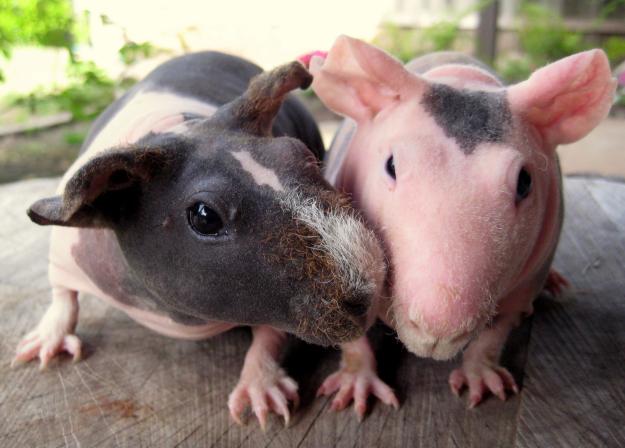
Hypoallergenic breeds of bald rodents, bred by dermatologists, live for about 5 years (in rare cases, the mark reaches 8)… These include:
- Skinny. Wool is present only on the paws and muzzle.
- Baldwin. They have elastic skin, devoid of hair follicles. A newborn animal is distinguished by the presence of a fur coat that disappears a couple of months after its birth.
Among the presented breeds of guinea pigs, short-haired ones live longer, which is explained by the ease of care and the absence of specific gene diseases.
IMPORTANT! It is worth giving the position to the breeders. Thanks to painstaking work, they were able to achieve an increase in the average life expectancy of hairless breeds. Initially, such pets were distinguished by weak immunity, reducing the maximum age to the level of other small rodents (hamsters, rats).
Factors affecting longevity
How long a guinea pig lives depends not only on its breed. The final figure is made up of a number of other more important factors.
Conditions of detention

At home, the animal is constrained in activity, so it is important to support and stimulate its physical activity. For this you will need:
- a spacious cage or terrarium (40x30cm for 1 pig), providing freedom of movement;
- a set of structures for games (tunnels, bags, socks and other popular toys), which brings not only physical, but also moral satisfaction;
- periodic walking, allowing you to stretch your legs over a larger area at home or on the street.
Care
For the health of your pet, it is important to monitor:
- the condition of his coat, preventing the formation of tangles, loss of color and loss;
- the number of baths, resorting to washing only when necessary and using special hypoallergenic shampoos (be sure to dry the animal with a hairdryer after bathing to avoid hypothermia);
- the quality of the litter, avoiding dubious or unsuitable fillers according to individual criteria;
- the health of the eyes and ears, cleaning them of accumulated dirt and checking their general condition;
- the length of the teeth, filed by the veterinarian as needed (excessive length can be fatal due to starvation);
- claws, shortening them with a nail cutter in case of impossibility of self-grinding;
- temperature conditions during bathing (not
Received heredity
The only factor that should be taken for granted, because it will not be possible to change the genetic code.
Diet
Food rich in all the necessary vitamins helps to prolong the life of a small pet. Rodents are not able to independently generate vitamin C, so they need additional preparations. The daily diet should include:
- specialized feed – 60%;
- branches of fruit trees, crackers, hay – 20%;
- fruits and vegetables – 20%.
General health
A strong immune system does not need to be vaccinated, so it is enough to monitor alarming symptoms that require medical diagnosis:
- lethargic state;
- shortness of breath, wheezing, shortness of breath;
- upset stool;
- the appearance of alopecia and ulcers;
- convulsive seizures;
- loss of appetite, constant thirst or, conversely, refusal of water;
- extraneous discharge from the sinuses and eyes;
- sticking of wool in the abdomen;
- itchiness
Compliance with all conditions will help improve the quality of life of the animal, which will positively affect the final figure of its age.
Note that in old age, coming after 6 years of age, pigs need more care and more reverent care. Age-related problems with teeth and a decrease in the immune system require a revision of the diet and an increase in the amount of vitamins.
Table of age of guinea pigs by human standards
Breeders do not recommend purchasing rodents older than 2 years of age. In this case, it is difficult to deal with existing problems. With a small pet, the system is built gradually, so its foundation is laid directly by the owner. Any health problems are the responsibility of the owner (except genetic problems).
IMPORTANT! You can check the compliance of the declared by the seller and the real age of the animal by measuring the weight. Monthly animal weighs about 0,5 kg. At 1 year and 3 months, the maximum rates reach 1 kg in females and 2 kg in males, and the minimum – 0,7 kg and 1 kg, respectively.
Due to the rapid development of a pet, 1 year of his life in relation to a person is about 10-15 years. Let’s consider how many years you can give a guinea pig if you keep score by human standards using the example of the following table.
| Guinea pig age (years) | Human age (years) |
| 0,04 (2 weeks) | 0,52 (approximately 6 months) |
| 0,5 | 6,5 |
| 2 | 26 |
| 5 | 65 |
| 7 | 91 |
* 13 years were used as a calculated indicator (as an average of the possible options). The figures are approximate and require individual calculations.
Conclusion
When purchasing a tiny family member, remember that the lifespan of a guinea pig depends on the conditions provided by the owner.
For a long and happy pet life:
- Try to minimize stressful situations. Do not place the cage next to a constant source of noise and be sure to explain to young children the rules of behavior with a rodent.
- Avoid depression. Play with the animal and take him for walks so that he does not get bored with cellular life. The ideal option would be to acquire a roommate (avoid choosing 2 males, they will fight for territory).
- Maintain physical activity. Provide the house with all the necessary paraphernalia that can brighten up the pet’s pastime.
- Follow the balance of the diet. Do not forget about vitamins and avoid overfeeding (rodents are prone to obesity).
- Respond promptly to any warning signs. Don’t be afraid to contact your veterinarian. Remember that early diagnosis will minimize possible risks and provide quick and easy therapy.
How many years do guinea pigs of different breeds live and what determines their life expectancy
3.3 (66.83%) 249 votes



